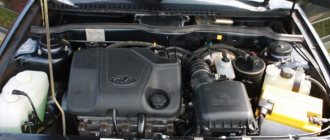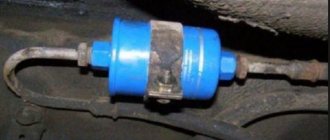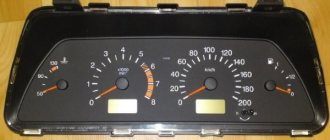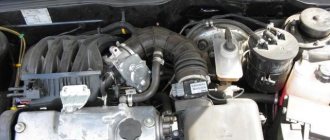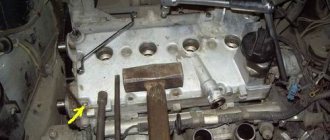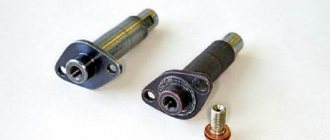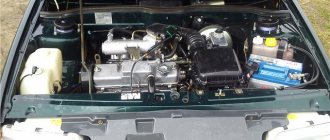The VAZ 2114 car is a high-quality modification of the most successful creation of the Volga Automobile Plant VAZ 2109. The model was named “Samara 2”. Its presentation took place in 2001. While the car entered mass production only in 2003. Later, an even more improved VAZ 2114 16 valve appeared on the domestic market. We will look at this model in more detail in our review.
Differences between VAZ 2114 and VAZ 2109
The improvements of the VAZ 2114 in comparison with the prototype turned out to be more than serious. They affected both the appearance and the technical part of the car.
2114 designers made a number of changes:
- new front and rear bumpers installed;
- updated version of the hood;
- the model received improved optics;
- the radiator was lined;
- added a package of moldings.
The interior of the car has changed even more. The instrument panel and steering wheel were completely replaced. To improve passenger and driver comfort, engineers replaced the outdated heater. The 2114 also received new front windshield wipers.
When to service the engine and what you need to know
So, on 2114, the engine needs to be serviced every 10-12 thousand km. mileage In this case, the main procedures within the framework of maintenance are:
• replacing engine oil and oil filter every 10 thousand km; • replacing spark plugs, air filter, fuel filter every 25 thousand km; • replacement of the timing belt, roller, high-voltage wires every 45 thousand km;
Please note that a broken timing belt will cause the valves to hit the pistons, the valves themselves will bend, and both the piston and the VAZ 2114 cylinder block may be damaged, etc. In other words, the valves on this engine are bent, and to eliminate the consequences, a major overhaul of the VAZ 2114 engine will be required.
For this reason, it is necessary to monitor the position of the timing belt and change it together with the roller according to the regulations or taking into account obvious signs of wear. Let us also add that experts recommend changing the transmission oil in the gearbox every 50-60 thousand km. mileage
As for engine oil, although the VAZ 2114 injector engines are similar, depending on the specific model of the unit, you only need to fill in the recommended oil. To understand what kind of oil to pour into the VAZ 2114 engine, you need to know exactly what kind of power unit is on the car.
To put it simply, according to factory recommendations, the best option for a VAZ 2114 engine for an 8-valve internal combustion engine is 10W40, while for a 16-valve engine it is better to fill it with 5W30. Experienced drivers and mechanics recommend using semi-synthetic oil, as it is the optimal solution in terms of quality and price.
Engine VAZ 2114
The most anticipated changes to the VAZ 2109 concerned the power plant. In the first generation, the model used an 8-valve engine 2114. It had a displacement of 1.5 liters. In the next update of the VAZ 2114, which occurred in 2007, this engine was replaced with an improved one with a volume of 1.6 liters.
The installation of a 16-valve engine on the VAZ 2114 was a real breakthrough for the model. This modernization was carried out entirely under the control of Super-Avto CJSC, part of AvtoVAZ OJSC. The most important characteristic of the 16 valve VAZ 2114 is the maximum power of 89 hp. Thus, the car is technically very close to foreign-made budget cars.
For comparison, we suggest you consider the following table of dynamic indicators:
| LADA 2114 8V | LADA 2114 16V | |
| Maximum power, kW/rpm/hp | 59,5/5200/81 | 66/5000/89 |
| Maximum torque, Nm at rpm | 120/2700 | 131/3700 |
| Fuel consumption in mixed mode, l/100km | 7,6 | 7,0 |
| Maximum speed, km/h | 160 | 190 |
| Acceleration to 100 km/h, s | 13,2 | 11,2 |
Typical breakdowns
The very first 1.5 liter engine 2114 has disadvantages:
- periodic valve adjustment;
- unreliable injection system;
- loosening the exhaust manifold nuts;
- Leaking gaskets of the fuel pump, distribution sensor of the ignition system.
The next 1.6 liter engine does not cause any particular problems for the owner, with the exception of high vibration and noise loads. The weak point traditionally remains the valves, which have to be constantly adjusted.
Adjustment of valves
The internal combustion engine from Lada Kalina 11183 was installed on the fourteenth model solely to meet Euro-3 standards. It has typical disadvantages for a linear series and is no different.
The first sixteen-valve engine 21124 does not bend the valves, the gaps in which are adjusted by hydraulic pushers. However, the belt needs to be tightened after 15,000 km due to the large number of attachments. The second and last in the line of fourteenth ICE models, ICE 21126, has increased power. In addition to typical malfunctions, if the timing belt breaks, the piston will bend the valve due to insufficient recess depth.
Road characteristics of the VAZ 2114
In addition to the fact that a 16-valve engine was installed on the model, the VAZ 2114 was significantly re-equipped to improve road properties. The car's gearbox with a gear ratio of 3.7 received a new package of “closed” bearings, which significantly increased the reliability and performance of the system, in particular the torque of the car.
For the braking system of the 16-valve VAZ 2114, engineers used larger diameter (up to 200) clutch brake discs than in 2109. In addition, the brake cooling system was improved, which made it possible to achieve not only safety, but also reliability.
The designers managed to achieve great success in terms of vehicle stability. This was mainly possible thanks to the installation of high-energy shock absorbers, as well as struts from the 2107 model. This set of procedures led to increased body rigidity, road stability, maneuverability and durability.
A little about the device and description
All engines were equipped with a 5-speed manual transmission. The gas distribution mechanism is belt driven. The first and second generations of vehicles (manufactured before 2007) were equipped with a simple on-board computer that did not regulate the operation of the engine from sensors.
Subsequently, it was decided to install ECUs that would completely regulate the performance of the motor using control sensors and regulate all ongoing processes.
Price for VAZ 2114
Of course, most owners of domestically produced cars choose VAZ cars precisely because of their low cost. The price for the 16 valve VAZ 2114 is in an equally acceptable range, but at the same time you can count not only on efficiency, but also on fairly good performance of this vehicle.
Prices today for a 16-valve model fluctuate around 300 thousand rubles.
Engine 2111 (1.5 l., 8 valves)
At its core, the engine is a redesigned modification of the well-known 21083 unit, which appeared on the legendary G8. The processing affected, first of all, the food system. Instead of a carburetor system, the engine began to be equipped with an injection system. The design of the connecting rod and camshaft also received changes. All this made it possible to improve technical characteristics. Power and torque have increased. In addition, the engine began to comply with Euro-2 environmental standards.
Gas distribution mechanism with overhead camshaft and belt drive. Its nice feature is that if the valve belt breaks, it is not susceptible to damage.
Typical problems
Floating idle speed most often occurs due to malfunction of the following components:
- Idle air control;
- Throttle position sensor;
- Vacuum booster.
If the existing symptoms are supplemented by the fact that the engine stalls while driving, then you should also pay attention to the condition of the mass air flow sensor (MAF).
If the engine begins to run unevenly and “triple”, then first of all you should pay attention to the compression indicators. Noticeably lower compression in one of the cylinders most likely indicates a burnt out valve. If the spread is small or exists in several cylinders, then the valve clearances should be checked. There is a high probability that they require adjustment. A similar symptom may also indicate problems with the gasket between the cylinder head and the cylinder block. However, even if such symptoms are not observed, do not forget to regularly check the thermal clearances of the valves, as well as adjust them. The manufacturer recommends performing this check every 20 thousand km. If everything is fine with compression, but there are similar symptoms, you need to check the ignition module.
Often noises and knocks become companions of this motor. All of this can be caused by out-of-adjustment valves. If you experience an increasing loud, dull metallic sound when you press the gas pedal, the engine will most likely need to be repaired. There are several main reasons for this symptom:
- Knock of main bearings;
- Knock of connecting rod bearings;
- Knock of pistons.
The operating coolant temperature range for this unit is 95-103 degrees. However, there are often cases when the engine simply does not heat up to such levels. The main reason for this behavior of the motor is a malfunction of the thermostat. Some owners have to replace it almost on a regular basis. All this is a consequence of the low quality of spare parts.
Other common malfunctions of this engine
- Valve cover leaks;
- Wear of cooling system components;
- Failures of the injection system on old copies;
- Breaking off the fastenings of the exhaust exhaust pipe (can be treated by replacing the steel threaded connections with brass ones).
The engine is very common and deservedly popular among many car enthusiasts. Its simplicity, maintainability and good knowledge make it easy to cope with existing shortcomings and characteristic malfunctions.
The manufacturer officially declares a resource of 150 thousand km. However, practice shows that many specimens are nursed deep beyond 200 thousand km. A lot depends on operating conditions and attention to maintenance.
Reviews of VAZ 2114
Reviews about the 16 valve VAZ 2114 can be said to be mostly positive. In comparison with the 8-valve version, drivers highlight:
- Reduced fuel consumption;
- Increased power;
- Improved overall dynamics.
On the other hand, let's not hide it and look at the weaknesses of the car. As you know, the 16 valve model never entered mass production, and this led to several negative factors at once.
- Firstly, it is not always possible to obtain good quality assembly, which is carried out at Super-Avto CJSC.
- Secondly, the car is expensive to repair, as some spare parts are difficult to obtain.
Engine 21126 “Priora” (1.6 l., 16 cl.)
A continuation of the evolution of VAZ 16-valve engines was the engine with index 21126. It is a development of 21124, but with some changes. Among them:
- Lightweight ShPG (connecting rod and piston group);
- Better surface treatment;
- Honing of cylinders with more stringent requirements.
The timing drive is a belt drive with overhead camshafts. But unlike its predecessor, when it breaks, the valve bends. There is a radical solution to this design feature - replacing the pistons. If the engine is of a standard design, then you just need to carefully monitor the condition of the belt. Moreover, the problem with its weakening was solved by installing an automatic tensioner. The type of belt used was also changed.
Typical faults
If you feel a loss of power, then most often the reasons for this are the following phenomena:
- Loss of compression due to a burnt-out cylinder head gasket;
- Wear of the cylinder wall;
- Wear of piston rings;
- Piston burnout.
The result of unstable operation and refusal to start may be a problem with pressure in the fuel system. In addition, such symptoms are caused by sensor malfunctions, air leaks through leaky hoses or their connections, timing problems, or problems with the throttle valve.
If the engine is clearly “troubling”, then, first of all, it is necessary to check the compression readings to eliminate the problem of valve burnout. But more often this is caused by faulty spark plugs or a malfunctioning ignition coil. Sometimes the reason lies in the condition of the injectors, namely in the degree of their contamination.
Floating speed is a completely typical disease of VAZ 16-valve engines. Often, in addition to this, the engine runs unevenly. In this case, first of all, it is necessary to check the mass air flow sensor (MAF). If it is working properly, then most likely the cause is the throttle valve. It is necessary to clean it, and possibly replace its position sensor (TPS). At the same time, you should check the condition of the idle air control (IAC).
This engine was not without its signature headache with the thermostat. It also becomes the reason that the engine cannot warm up to operating temperature. However, if there is severe frost outside, perhaps the old-fashioned method of using cardboard in front of the radiator will help.
Some characteristic problems of other VAZ engines migrated to the 21126 Priora. So, if you detect knocking noises under the hood, you should first check the condition of the hydraulic compensators. Most often, they are the culprits of unpleasant knocking noises. At the same time, knocking noises that are associated with main and connecting rod bearings, as well as pistons, familiar from other VAZ engines, can also occur. This is already a serious malfunction, which is fraught with difficult engine repairs.
Minor problems, such as refusal to start, most often lie in the following malfunctions:
- Starter and battery;
- Ignition coil;
- Candles;
- Fuel pump malfunction;
- Clogged fuel filter;
- Faulty fuel pressure regulator.
Having improved its technical characteristics, the 21126 motor is still slightly inferior to its predecessor 21124 in reliability. Although it cannot be said that it is inferior very significantly. This is mainly due to the more complex design. Nevertheless, it is one of the best domestic engines, which also fits into modern environmental standards.
The declared resource is 200 thousand km. Compared to the officially declared resources of its predecessors, it has increased. However, in practice, older motors with a simpler design generally last longer. If we judge by reviews of actual use, then on average the actual resource corresponds to that specified by the manufacturer. Sometimes it can be more, sometimes less. Much depends on operating conditions and level of service.
DESIGN FEATURES
The engine we are considering has a cast cylinder block, the oil supply holes in which are machined, and the holes for antifreeze are made during the casting process. The engine cylinders are also machined inside the monolithic structure.
At the bottom of the structure there are supports for the main bearings, the covers on which are an irreplaceable part of the engine - they are adjusted to size at the stage of manufacturing the supports, and it is impossible to find two covers of the same size.
Inside the supports there are inserts made of a steel-aluminum alloy, and inside the third support there are half rings that prevent axial displacement of the crankshaft.
The pistons of the VAZ 2114 engine are aluminum, with cast steel rings, the connecting rod is steel. The cylinder block of the fourteenth is placed on a metal tray, on top of which a vibration-damping lining is laid.
Owners of the fourteenth are advised to check the integrity of this lining from time to time, since when it wears out, the sump, which is a hollow container for storing oil, can be damaged when driving over uneven surfaces due to the pressure of the cylinder block.
The crankshaft, located under the cylinder block, is equipped with a mount for the flywheel. The lightweight flywheel on the VAZ 2114 has a special mark, through which its correct location on the crankshaft flange is selected - it must be placed strictly perpendicular to the connecting rod journal of cylinder No. 4.
What is the salon equipped with?
The exterior of the VAZ is not for everyone. In order for the car to somehow correspond to the spirit of youth, the manufacturer gave the body sporty features: it rounded the hood, extended the headlights and moldings, and decorated the sill and bumper with body-color trims.
The interior is simple, but corresponds to the era of the early 2000s. The seats can hardly be called comfortable, so many people install an adapter or change the driver's seat. Although there is a Europanel, there is no glove compartment there. The only options available are power windows and an illuminated dashboard.
An unexpected bonus from AvtoVAZ is an adjustable steering column. It will allow you to raise and lower the steering wheel to the desired height to suit the height and build of the driver.
The trunk of the “fourteenth”, like the glove compartment of a jeep, is 330 liters. This will include a suitcase and a couple of bags from the supermarket. With the rear seats folded down, cargo space nearly doubles.
Pros and cons of the “four”
Owners about the peppy engine. Acceleration dynamics are 17 seconds/100 km, which is not bad at all for domestic cars. Fuel consumption is 7 liters per 100 km in city mode and 5 liters on the highway.
The ground clearance is not bad - 16.5 cm. The car is adapted to “killed” roads and goes well in the snow. The suspension is strong and rarely breaks. But when hitting a hill, the front suspension extension fasteners may be damaged. The reason is the fragility of the aluminum “crab”.
Gearbox synchronizers wear out quickly. To avoid buying a car with such a breakdown, move the shift lever during the inspection. If you hear extraneous sounds, there is something wrong with the synchronizers.
Due to the softness of the metal, dents and mechanical damage easily appear on the body. The metal is not galvanized, so rust is a natural phenomenon for the “four”. Spots appear in the contours of the arches, sills, places where the bumper and moldings join the body. The quality of the paintwork is average and prone to chipping.
And the saddest thing about the car is the lack of passive (not to mention active) safety features. There are no airbags or seat belt pretensioners in the cabin. If the car collides with an obstacle, passengers may receive injuries of varying severity: from bruised shins to fractures of the chest and cervical vertebrae.
Car parts are relatively inexpensive. The bumper can be bought for 3,500 rubles, the hood for 7,500 rubles, and the engine is estimated at 10 thousand rubles. For comparison, for a new bumper of the popular Lacetti in Russia they are asking 5,000 rubles, for the hood - 8-12 thousand rubles, for the engine - 30-60 thousand rubles.
How to convert an 8 valve engine to a 16 valve Installation features
The bolts may be visually very different from each other, but do not be alarmed. Modified bolts must be used.
Such bolts have the following characteristics:
- The diameter is equal to an 8 valve bolt;
- The length is 16 valve.
To make it easier for these bolts to fit into the hole, they should be pre-drilled. If you install the modified bolts according to all the rules and as carefully as possible, then the reliability of the engine can only be envied.
Cylinder head bolts VAZ 2114
When the car owner thinks that he is not able to perform this operation on his own, then it is better for him to seek help from qualified craftsmen with sufficient experience. They will definitely do everything right and as it should be.
An additional option to increase the power of the car is to tune the exhaust manifold. This is a great way to increase the power of your vehicle a little more.
